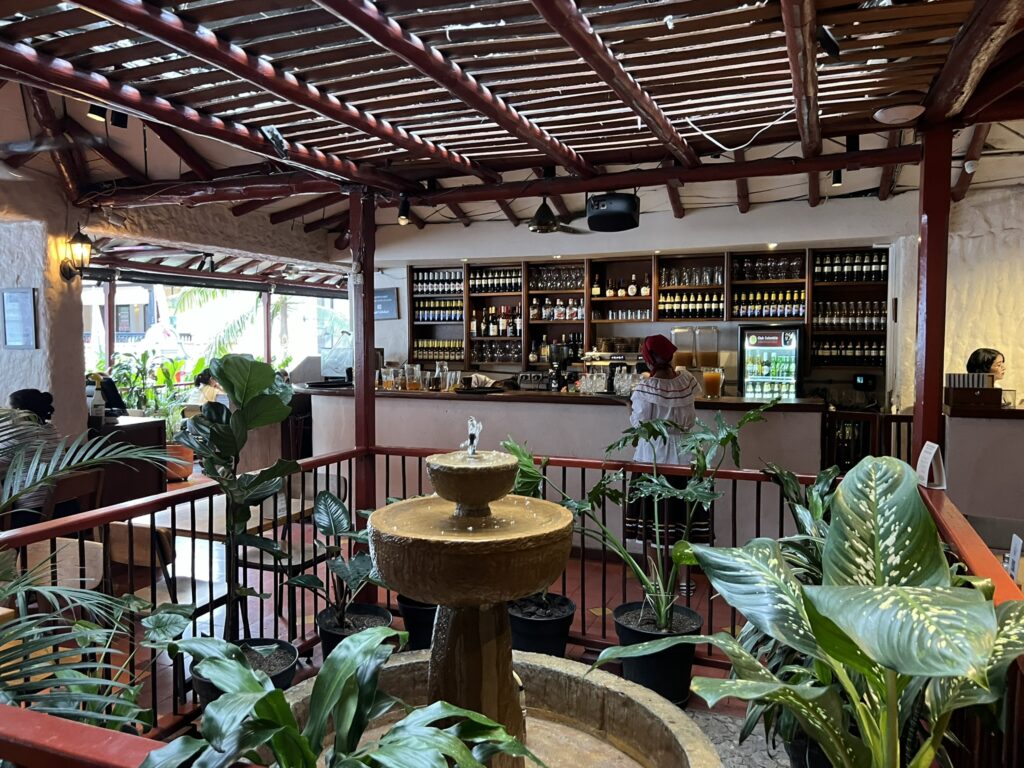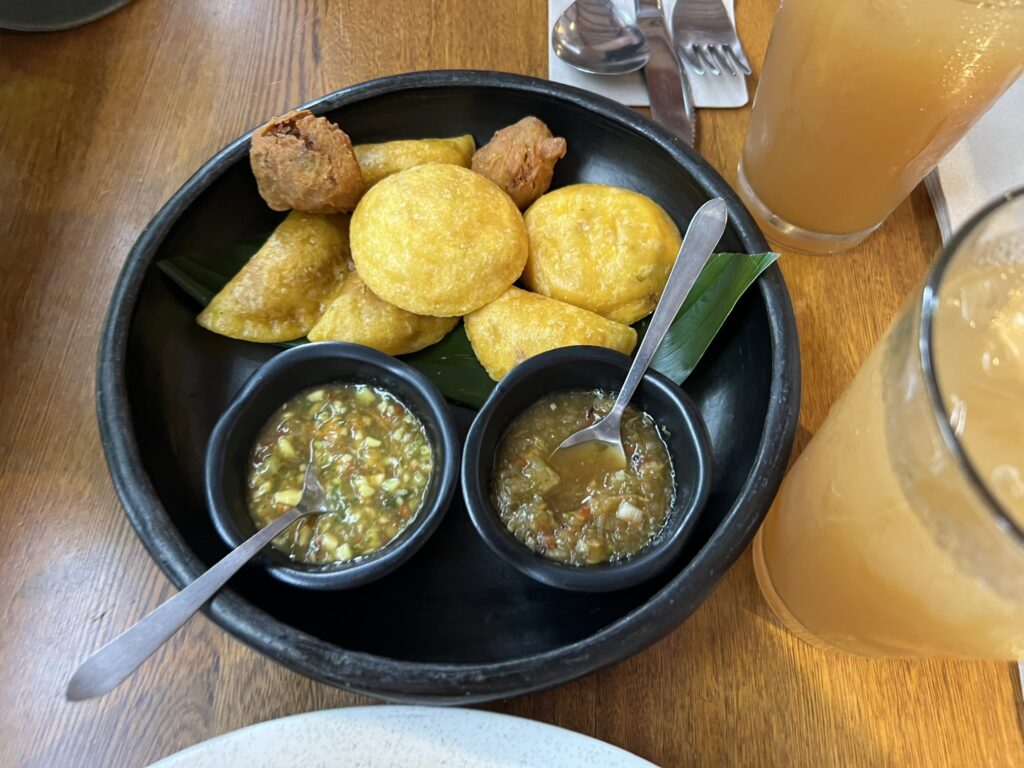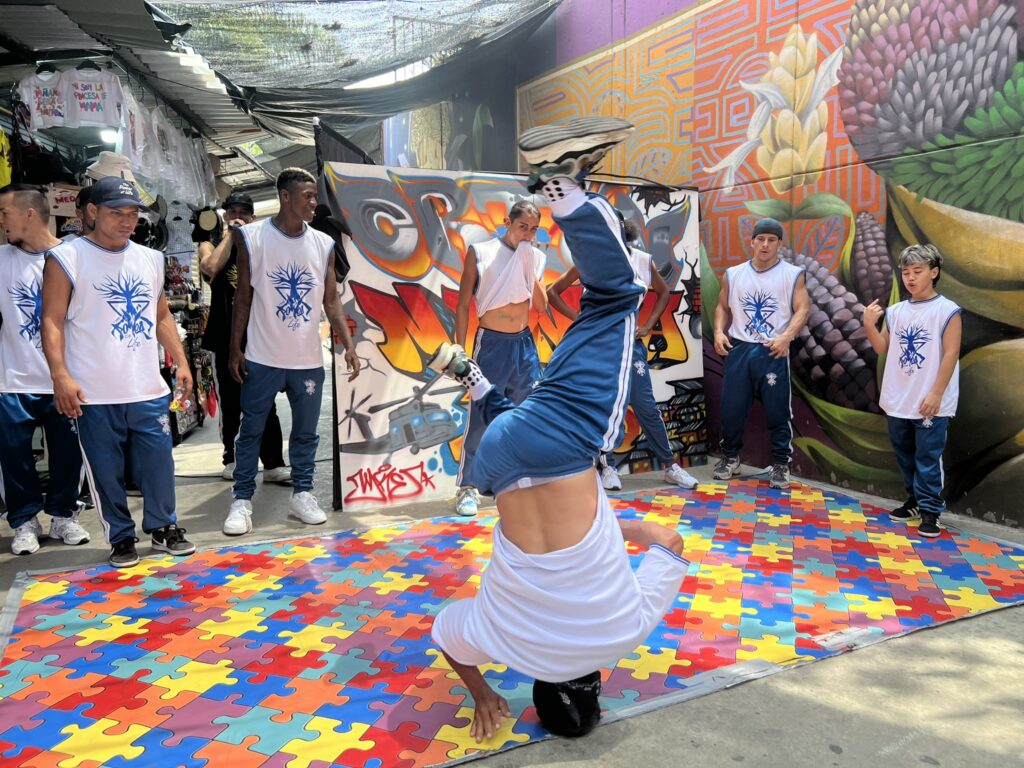Medellin is the second largest city in Colombia and is known as the city of eternal spring due to its pleasant climate. We learned about the recent transformation of this region while visiting Medellin.
Best Thing I Ate This Week
Visiting Medellin? Eat Bandeja Paisa at Restaurante Hacienda Junín
In Colombia, there are about 10 cultural regions of the country, which include the islands of San Andres and Providencia off the coast of Nicaragua. Medellin is the capital of the Antioquia department and is considered part of the Paisa cultural region. The Paisa region is known in Colombia as being one that is very proud of their culture. They are also a very welcoming region as we found many people eager to say hello or just talk to us about where we came from and how we were enjoying our visit.

The most well known dish from this cultural region is the Bandeja Paisa (tray of Paisa food). This dish includes beans, rice, avocado, plantain, egg, sausage, blood sausage, chicharron, beef, and an arepa. It is a hearty plate that many people eat for lunch on a big day of activity, or they order it for sharing with a second person if they are not super hungry.
For over 30 years Restaurante Hacienda Junín in the Centro neighborhood of Medellin has been serving delicious dishes made with products of excellent quality that highlight the local gastronomy at the best price. The restaurant has been so successful that it has grown to include 5 other locations. We were recommended to visit this restaurant by a Paisa (person from the region) to best try the local food.


The dining room of the restaurant was on the second floor of a building overlooking a busy pedestrian street of Medellin. The middle of the room had a nice fountain and was filled with Colombians which made the experience feel authentic from the start. We did not think we could finish a full bandeja paisa so decided to split it as a main dish and also start with an order of the antojitos antioquenos (Paisa snacks) to sample a few more regional items. The snacks included a variety of fried starters filled with meat, chicken, and potatoes. They were tasty and in particular the spicy salsas with pineapple and avocado were delicious when combined with the snacks. When the bandeja paisa arrived, we were happy to have only ordered one to split as it was a generous portion of food. Highlights of the dish for me included the sausages, beans, and plantain but everything was very good. Overall the lunch was delicious and a great way to try the traditional food of the Paisa region.
An Interesting Fact I Learned
Comuna 13 is the most popular destination when visiting Medellin
When researching places to visit in Medellin, the neighborhood of Comuna 13 continued to come up. We looked into Comuna 13 in more detail and determined it would be worthwhile to visit with a tour guide to learn more about the historical context of what makes this neighborhood so important. We found a local non-profit called the Insiders Foundation that is run by Sergio who grew up in the neighborhood. Sergio wanted to do his part to reinvest the benefits of increased tourism into his community so that the greatest number of people from Comuna 13 could improve their lives from the newfound popularity.

Our tour with Sergio started at the Insiders Foundation, which faces the hill that Comuna 13 is built on. We learned that Comuna 13 has become so popular that it is now considered the most visited location in all of Medellin. However, this was not always the case as Sergio shared more about his personal experience living there as a kid in the 1990s and early 2000s. The neighborhood used to be occupied by FARC and ELN (Colombia’s largest gorilla groups) because of its strategic geographic location. Sergio explained how conflict and violence were a normal part of his childhood, even showing some of the bullets he used to collect as a kid. The violence was so intense and frequent that emergency responders stopped coming to help the community. In October of 2002 the Colombia government launched Operation Orion, one of the largest ever urban military operations. Together, we watched a news clip about the operation and learned that while the end result did expel the guerrillas, there was also an enormous toll to the community members as well.

The rest of our tour was spent walking through the community and seeing first hand how Comuna 13 went from active conflict to top tourist destination. The community rallied around hip-hop and graffiti, vowing to give young people an opportunity to express themselves in a positive way so that they would not return to the violence that they had lived for so long. We learned that this process took many years as gangs that used to recruit the young people were upset that they were no longer interested in signing up. However, even in the face of tragedies the community persisted and today thanks to all these efforts it is one of the safest areas of Medellin. Comuna 13 is so safe that thousands of tourists come each day to view the beautiful murals throughout the community and watch incredible break dancing performances.

We thoroughly enjoyed our visit to the neighborhood and were moved by the story of progress for Comuna 13. As a parting thought for our tour, Sergio shared that because of the popularity, many outside investors have now started to buy up properties from locals and transform them into commercial tourist shops. This provides one time cash to locals who then move out to other areas of Colombia but are no longer in close proximity to their families. Sergio hopes that through his Insiders Foundation he can educate the community on how they can keep their homes and benefit from the tourism directly themselves. It is a long road ahead, but he is optimistic that with the right support he can be a catalyst for the next phase of progress for Comuna 13.
My Travel Tip of the Week
Arrive at Piedra del Peñol and Guatape early if day tripping

The most popular destinations to visit outside of Medellin are the Piedra del Penol (Penol rock) which overlooks the Embalse del Penol (Penol reservoir) and the town of Guatape. While Medellin is located in the Aburra Valley, these locations are located about 80 km (50 mi) outside of the city at a higher elevation in the Andes Mountain. It is a beautiful part of Colombia and much more relaxing than the busy urban life of Medellin. If we were to return to the area in the future, our preference would be to stay there a few nights to fully appreciate the beauty and tranquility.

However, like most people visiting Medellin, we only had a limited number of days for our trip and the best option for us was to book a full day tour to both destinations from Medellin. The company that we chose left from Parque de El Poblado at 7am which initially felt a little too early. Starting the day early did have its benefits, as we were the first tour bus to arrive at the Piedra del Penol and the town of Guatape. This meant that we could enjoy the amazing views from the top of Piedra del Penol and wander the beautifully painted streets of Guatape without large crowds of people in all directions. When we arrived at our final activity of the day, a boat ride on the Embalse del Penol, all of the tour buses arrived at the same time. It was at that moment I realized the enormous quantity of people that were also doing the tour but were slightly behind us on timing on the two main stops. Our guide Marlon told us this was the low season crowd and that during the high season it is many times more people. Given all of this, I was glad for the early wake up and would do it again if taking a day trip to these locations from Medellin.

My Additional Anecdote This Week
A place can transform significantly in only a few decades time
Throughout our visit to Colombia we learned a lot more about their history of conflict and gained a better understanding of important events that shaped the country to where it is today. In recent times, Medellin best exemplifies the rapid transformation of Colombia from violence to a tourist destination. In the 1990s narco-trafficking groups such as the Medellin Cartel, led by the infamous Pablo Escobar, were responsible for so much violence that at one point Medellin was considered the most dangerous city in the world. During our visit to Medellin we tried to learn more about this transformation through various activities. These included:
- Real City Tours: Medellin El Centro Walking Tour
- Museo Casa de la Memoria
- Insiders Foundation: Comuna 13 Beyond the History and Graffiti Tour

Through these activities we started to have a better understanding of the pain and suffering endured by the everyday people of Medellin. It was remarkable to hear first hand stories and review interactive exhibits that humanized the immense toll taken throughout these times of violence. One of our guides (Hernan) who grew up in Medellin said that he believes the people of the city developed a mind set of short term memory to deal with the trauma. This helped them move on from focusing on the tragedies and instead live in the moment. Learning about the cultural attitude to live in the moment explained why most people we met in Medellin seemed so friendly and fully enjoying their days. However, Hernan also cautioned that it is important not to forget the pain and to honor the difficult times in the past so as to not repeat them.

As we prepared to leave Medellin and Colombia, I reflected on all that I had learned about the difficult history during our visit. Across all of the places we visited in the country, there were a large number of tourists and Colombia seemed to have more visitors than any other country we have visited in South America so far. This immense popularity was so remarkable given that less than 30 years ago it was one of the most dangerous places on Earth. It gave me optimism that other places dealing with violence and conflict may be able to follow a similar path to Colombia, and, in only a few decades, they too will achieve a transformation that at this time seems inconceivable.


